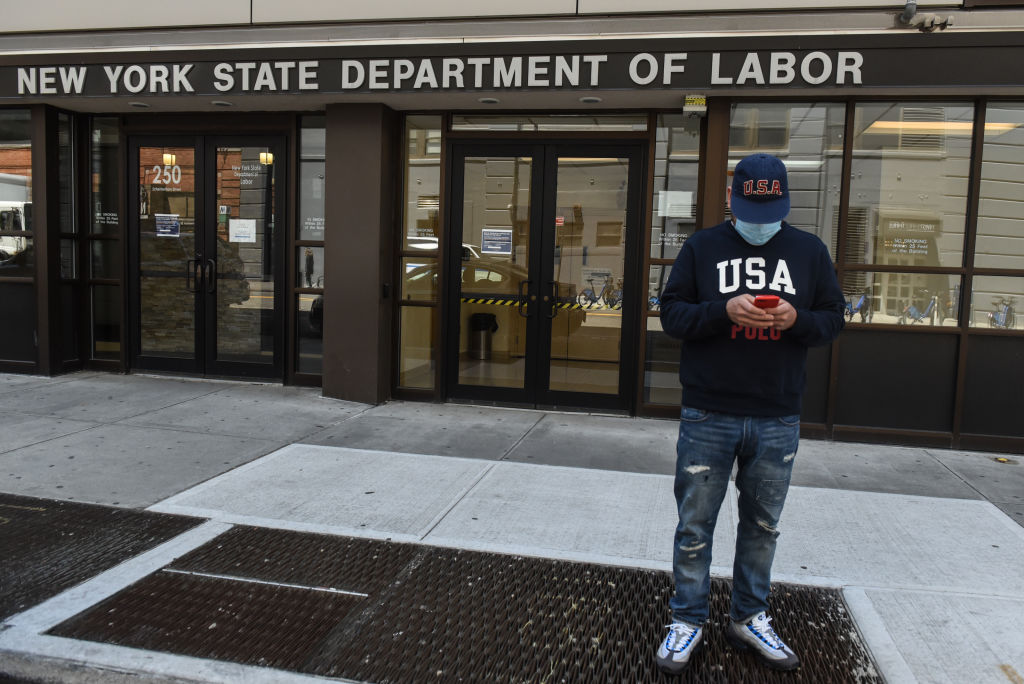Pandemic Nation
Permanent Job Losses May Be the Pandemic’s Second Act
A new study, citing historical precedent, claims 42 percent of recent layoffs will result in permanently lost jobs.
Co-published by Fast Company

As unemployment figures swell to historic levels, millions of Americans, including hourly wage-earners from the vast service economy, have been pushed toward a kind of forced optimism: When this is all over, we’ll go back to work.
Co-published by Fast Company
But using history as a guide, a new paper raises the strong possibility that millions of their jobs will vanish. What that might do to an already strained system of health and social services is the stuff of nightmares.
Listen to the “Pandemic Nation” Podcast
The report, produced by the Becker Friedman Institute for Economics at the University of Chicago, estimates that 42 percent of recent layoffs will result in permanent job loss. That figure is wildly at odds with what working people themselves think; in the Bureau of Labor Statistics’ most recent household survey, 78 percent of respondents described their job layoff as temporary.
Part of the study’s projection is based upon the economic fallout from previous recessions, co-author and Stanford University economist Nick Bloom told Capital & Main. That includes an accounting of how many “temporary” layoffs became permanent, and how many seemingly permanent lost jobs were, in the end, restored.
Each week Pandemic Nation offers a roundup and analysis of news about the coronavirus. Please send feedback and related tips and announcements to mark@markkreidler.com
Longer term, the authors predict a “drawn-out economic recovery from the COVID-19 shock, even if the pandemic is largely controlled within a few months.” In part, they say, that’s because history suggests it takes a year or more for broad-scale reallocation of jobs to begin occurring – that is, jobs lost in some areas leading to jobs created in sectors that suddenly need more employees.
The BLS reported that leisure and hospitality employment fell in April by 7.7 million, a staggering 47 percent drop-off that significantly affects hourly wage-earners who already live on the edge of financial stability. Many of these workers rely upon safety-net systems for their health care to begin with – but those community clinics are struggling to survive as well.
Some businesses are already acknowledging that many of their laid-off or furloughed employees won’t be coming back.
BLS put the official unemployment rate at 14.7 percent, but the bureau noted that the actual (though unofficial) figure is probably closer to 20 percent – nearly double the peak level of unemployment during the Great Recession of 2007-09.
While some businesses are acknowledging that many of their laid-off or furloughed employees won’t be coming back, the vast corporate sector is holding off on delivering similar news. Bloom, who said he has worked in the past with the public-relations arms of several such large companies, said it’s a matter of time.
“I bet many large firms have already decided to make a number of temporary layoffs permanent but are waiting for a good time to announce this,” Bloom said.
* * *
Officials in Los Angeles County say economic inequality and institutional racism are contributing to disproportionately high death rates from COVID-19 among certain ethnicities – and a new study, conducted by the AIDS research group amfAR, suggests that some of the same factors are affecting black people on a national scale.
In L.A., the death rate was 89 per 100,000 people among Native Hawaiian and Pacific Islanders as of last week, and 18 per 100,000 among black people. It was 15.5 for Latinos, 12 for Asians and nine for whites.
Will states’ reopening policies adversely affect
African-Americans in ever greater numbers?
“Systematic injustices, including discriminatory policies and institutional racism, have led to the unequal distribution of wealth, resources and opportunities, and this is in fact contributing to the staggering disproportionality we see in the outcomes around COVID-19,” Barbara Ferrer, public health director for L.A. County, said in a news briefing.
Experts say Pacific Islanders may be showing such unusually high rates because of underlying conditions that are not always treated, and because many of them hold “essential” jobs that require them to continue to show up to work in person.
Los Angeles County, with a population of more than 10 million, has California’s highest number of coronavirus cases, recording 1,569 deaths as of May 11. Ferrer called on officials to increase testing and coordinate care in poorer areas of the county.
The national study, meanwhile, found that blacks make up a disproportionate share of the population in about 22 percent of counties in America, and those counties account for more than half of coronavirus cases and nearly 60 percent of the deaths.
Gregorio Millett, amfAR’s vice president, told the Washington Post that the study’s authors were concerned that states’ reopening policies will adversely affect African-Americans in ever greater numbers.
Several public health experts have suggested that black Americans are more vulnerable to the coronavirus because of underlying health conditions, such as heart disease and diabetes. The amfAR report, however, found that social determinants are more significant to the spread of the disease through African-American communities.
“Structural factors including health care access, density of households, unemployment, pervasive discrimination and others drive these disparities, not intrinsic characteristics of black communities or individual-level factors,” the authors wrote.
* * *
Last week’s column reported the viral outbreak at the Terminal Island federal prison, where more than half the population had tested positive for COVID-19. But a different California facility now has the highest total number of infections of any such federal institution.
According to the federal Bureau of Prisons, the Lompoc Federal Correctional Institution in Santa Barbara County had recorded 902 cases of the virus by Monday – 891 inmates and 11 staff members. Terminal Island, in San Pedro, was next with 708 cases.
Nearly 75% of federal prison inmates in Lompoc
have tested positive for COVID-19.
Dr. Henning Ansorg, Santa Barbara County’s public health officer, said Friday that nearly 70 percent of inmates tested had come back positive; on Monday, per the BOP’s numbers, the figure was closer to 75 percent. Most displayed mild symptoms or none at all. County officials have expressed their frustration with the federal prison system for not being more cooperative or sharing information; families and legislators in San Pedro said the same about their situation last week.
* * *
The record job loss in the U.S. has led to widespread food insecurity, with two in five households with mothers with children under 12 facing that frightening reality by the end of April. California’s Education Department asked the U.S. Department of Agriculture to help it do something about that – to no avail.
The California agency requested that the USDA allow the parents or legal guardians of children eligible for free school meals to also pick up no-cost meals for themselves, the Washington Post reported. Prior to the pandemic, roughly 22 million students nationally received free or discounted lunches during an average school day this year. Parents or guardians of those students normally must pay full price if they also want a meal. The USDA declined California’s request last week, saying it lacked the authority to reimburse school districts that provide such meals.
Some school districts have taken action without the USDA’s approval, meaning they are unlikely to be reimbursed. Los Angeles Unified, the nation’s second-largest district, has since mid-March handed out millions of meals to students and anyone else who needed one. Districts in Massachusetts, New York and Michigan are among those known to have adopted similar policies.
Federal officials say it would likely take an act of Congress to change the current rules.
Copyright 2020 Capital & Main

-

 Latest NewsDecember 8, 2025
Latest NewsDecember 8, 2025This L.A. Museum Is Standing Up to Trump’s Whitewashing, Vowing to ‘Scrub Nothing’
-

 Striking BackDecember 4, 2025
Striking BackDecember 4, 2025Home Care Workers Are Losing Minimum Wage Protections — and Fighting Back
-

 The SlickDecember 2, 2025
The SlickDecember 2, 2025Utility Asks New Mexico for ‘Zero Emission’ Status for Gas-Fired Power Plant
-

 Dirty MoneyDecember 3, 2025
Dirty MoneyDecember 3, 2025Trump’s Anti-Climate Policies Are Driving Up Insurance Costs for Homeowners, Say Experts
-

 Child FarmworkersDecember 5, 2025
Child FarmworkersDecember 5, 2025To Protect Underage Farmworkers, California Expands Oversight of Field Conditions
-

 Column - State of InequalityDecember 4, 2025
Column - State of InequalityDecember 4, 2025Can California Claw Back Some Medi-Cal Care?
-

 Latest NewsDecember 10, 2025
Latest NewsDecember 10, 2025Capital & Main, L.A. Times Win Sidney Award for Reporting on Child Farmworkers
-

 StrandedDecember 9, 2025
StrandedDecember 9, 2025Giving Up on the Dream: Asylum Seekers Try Other Options in Mexico

